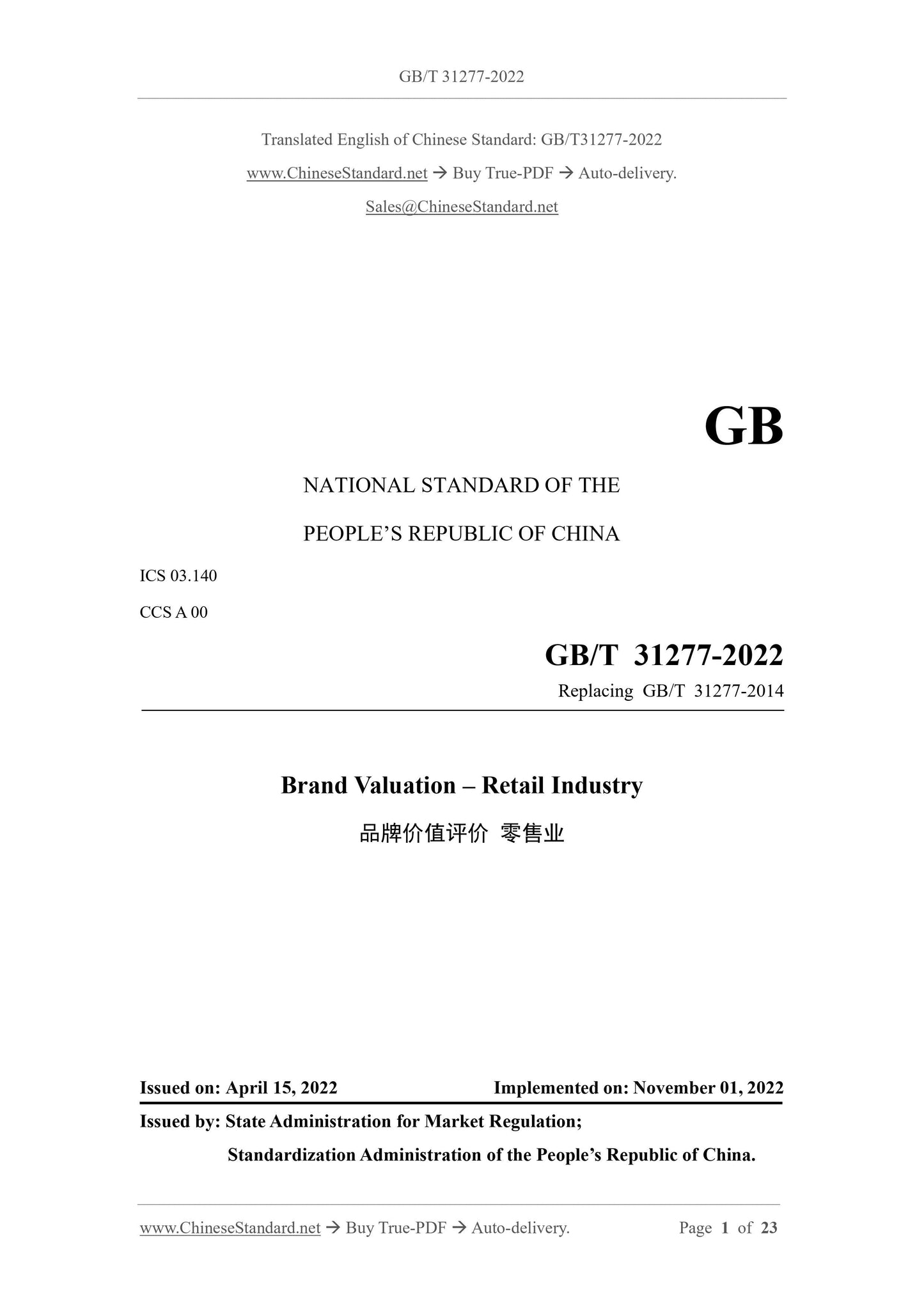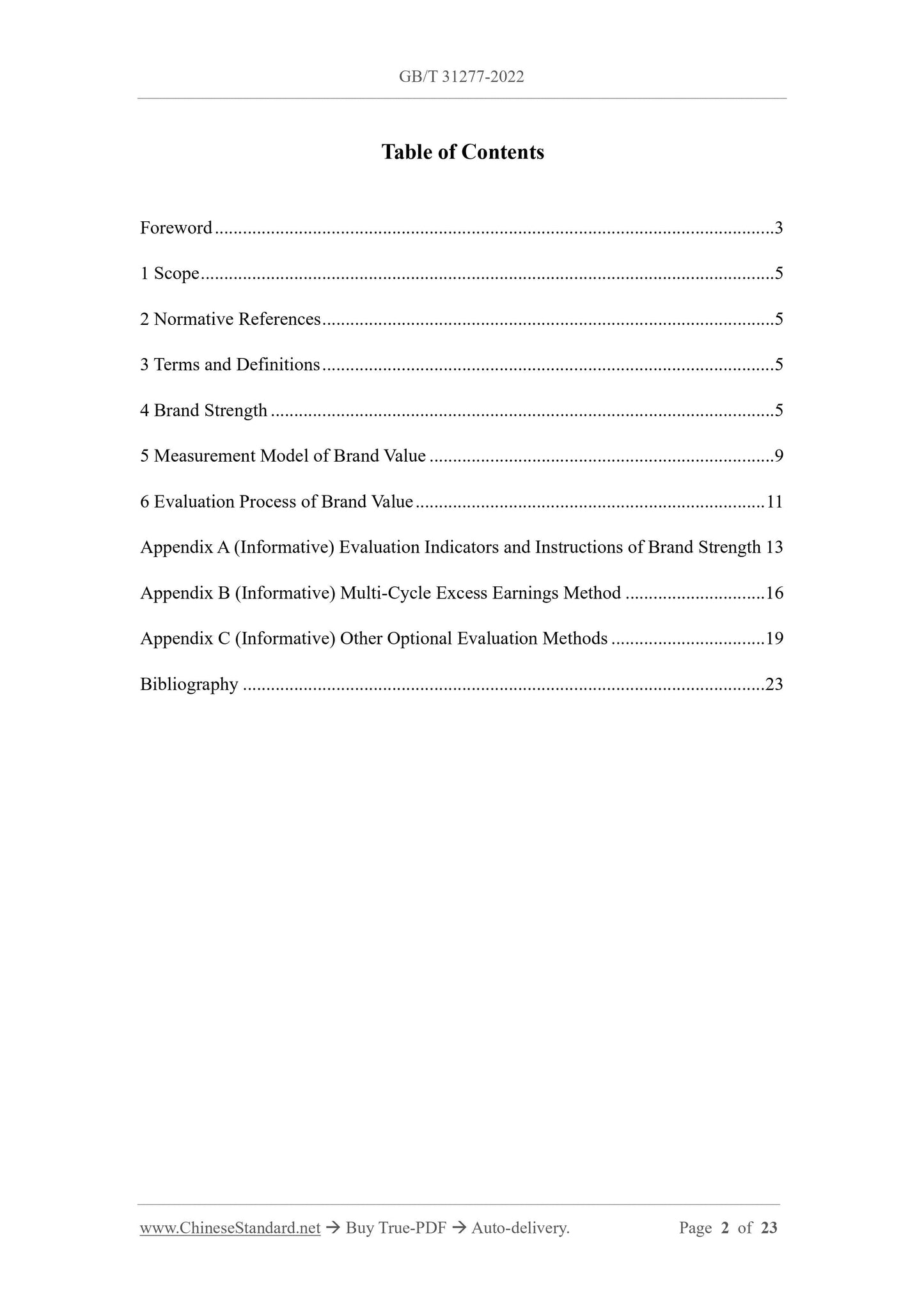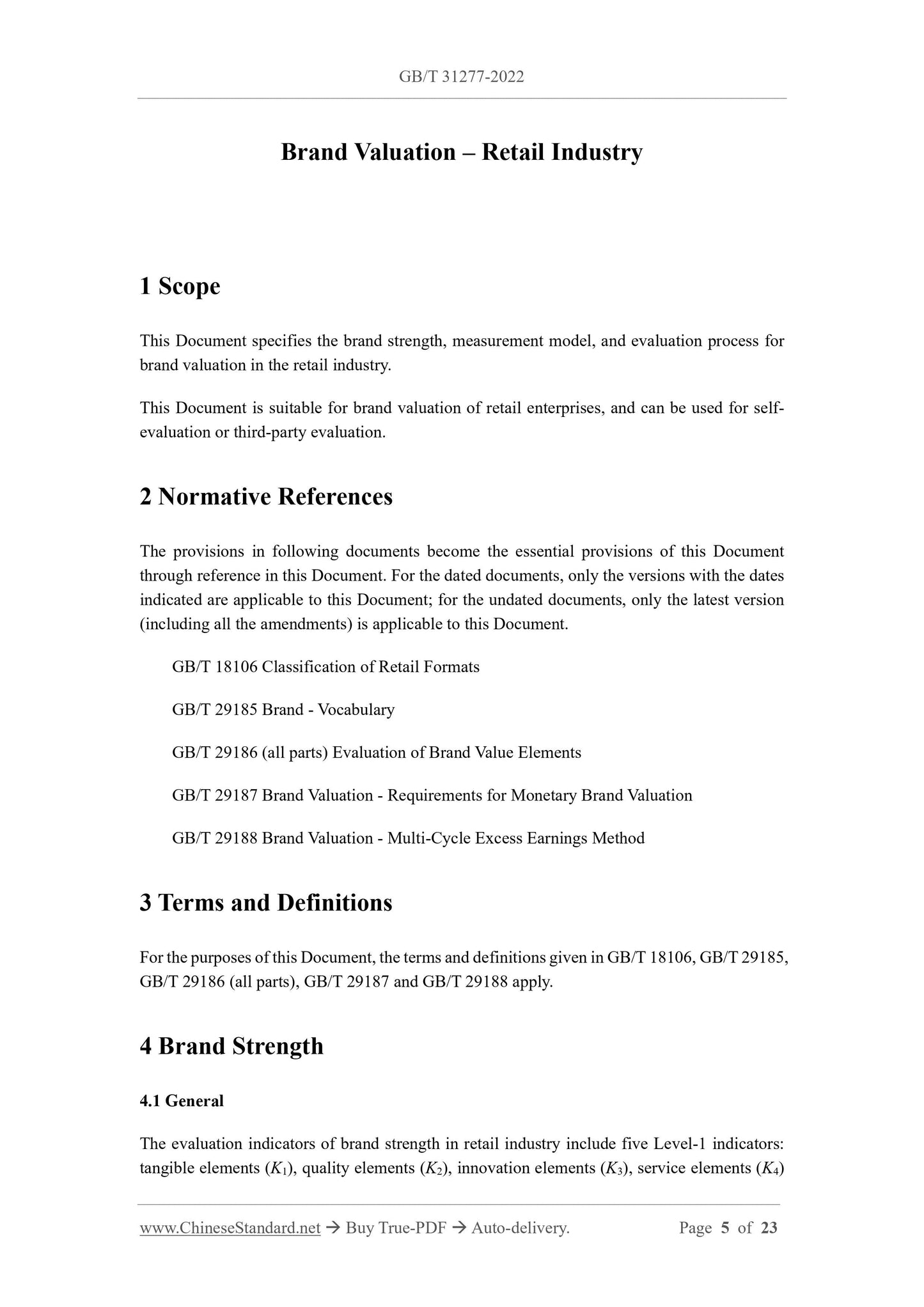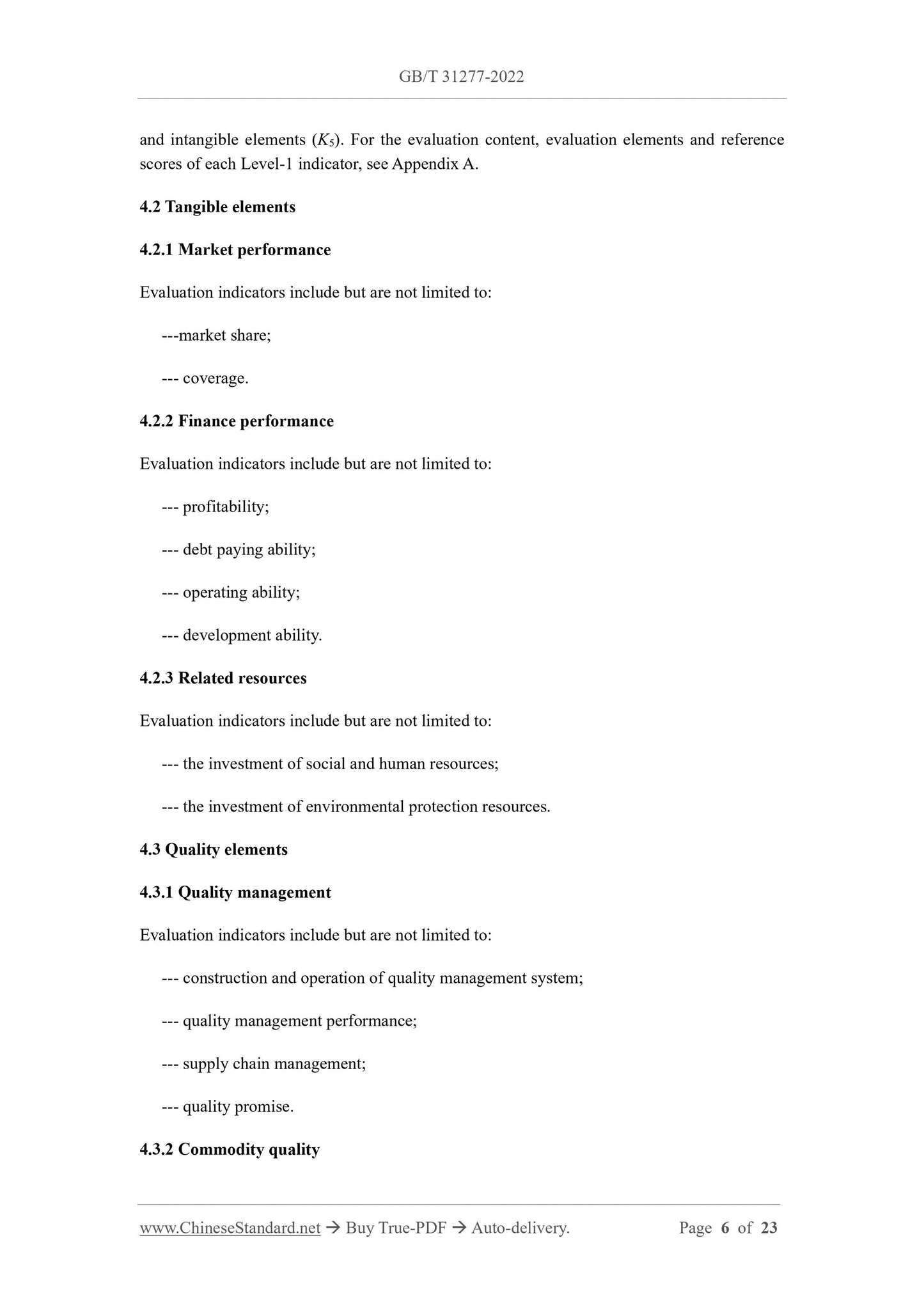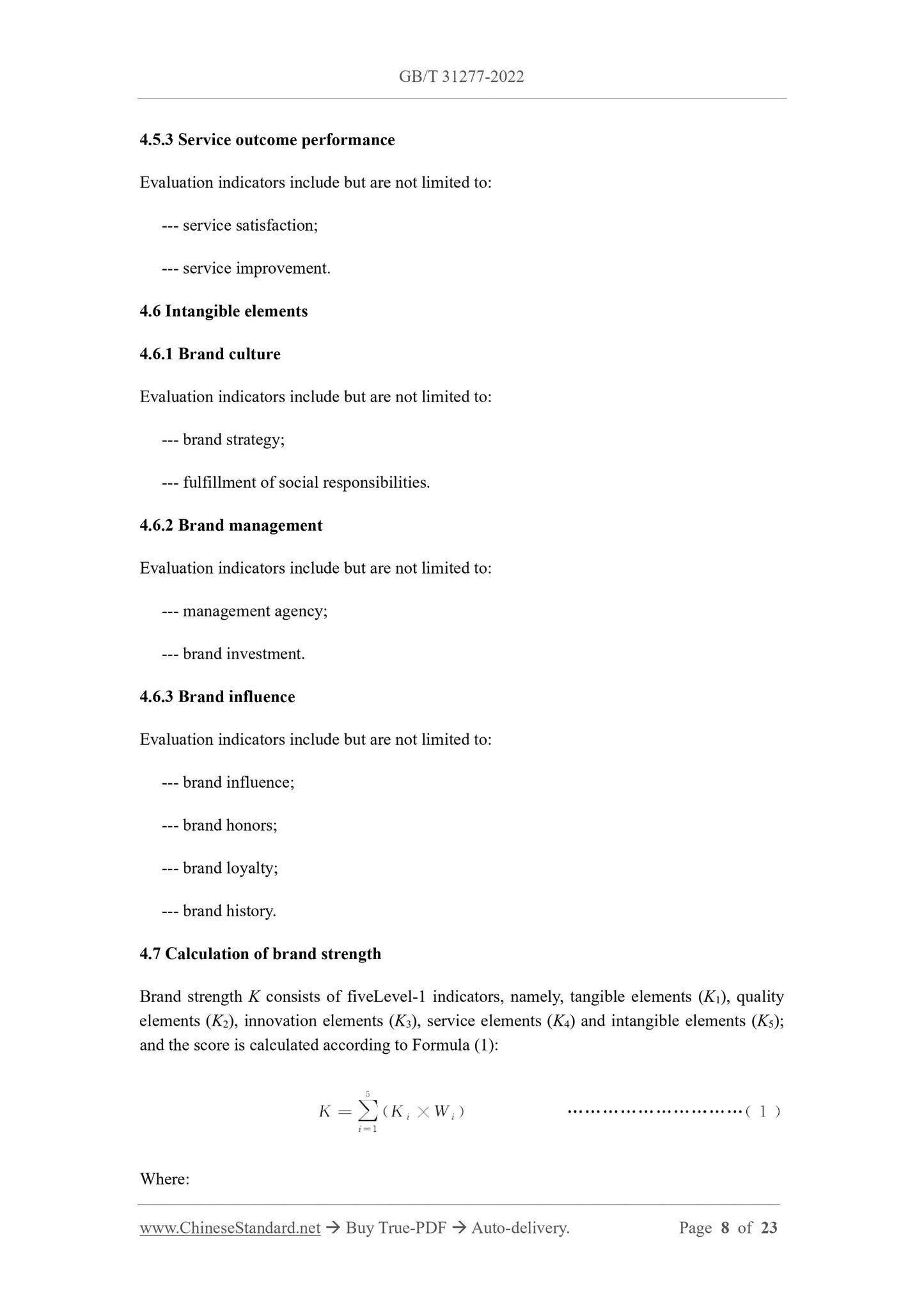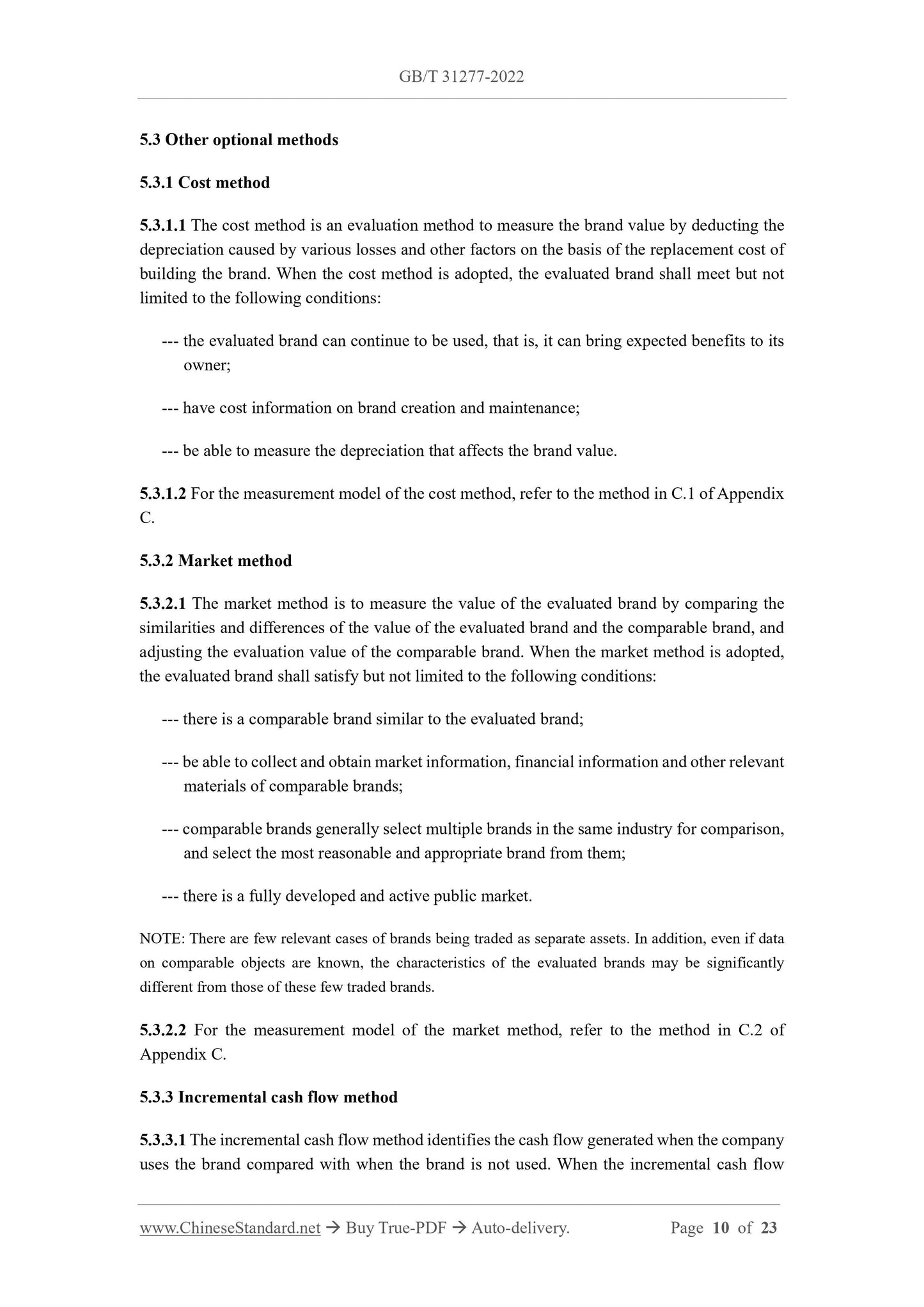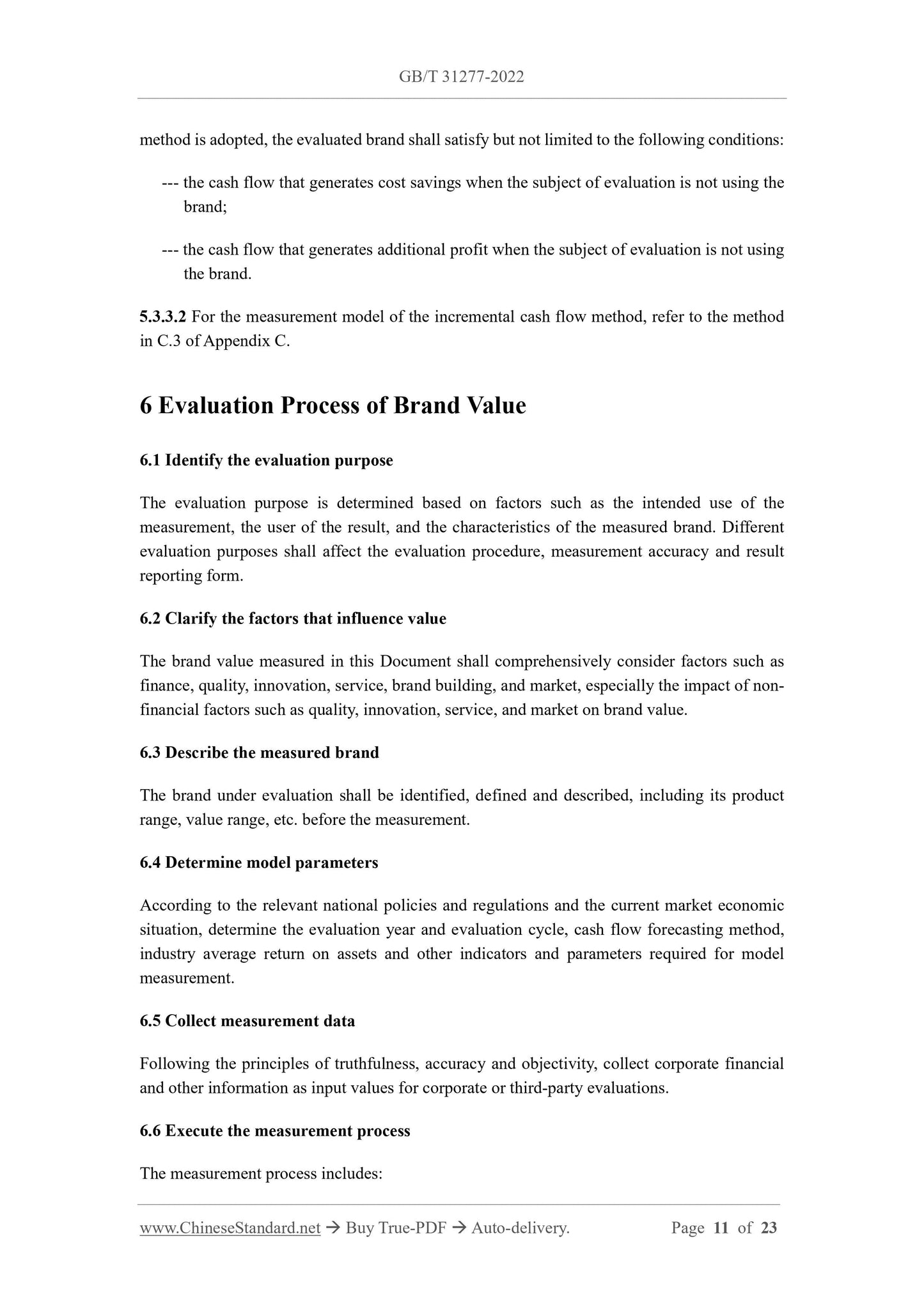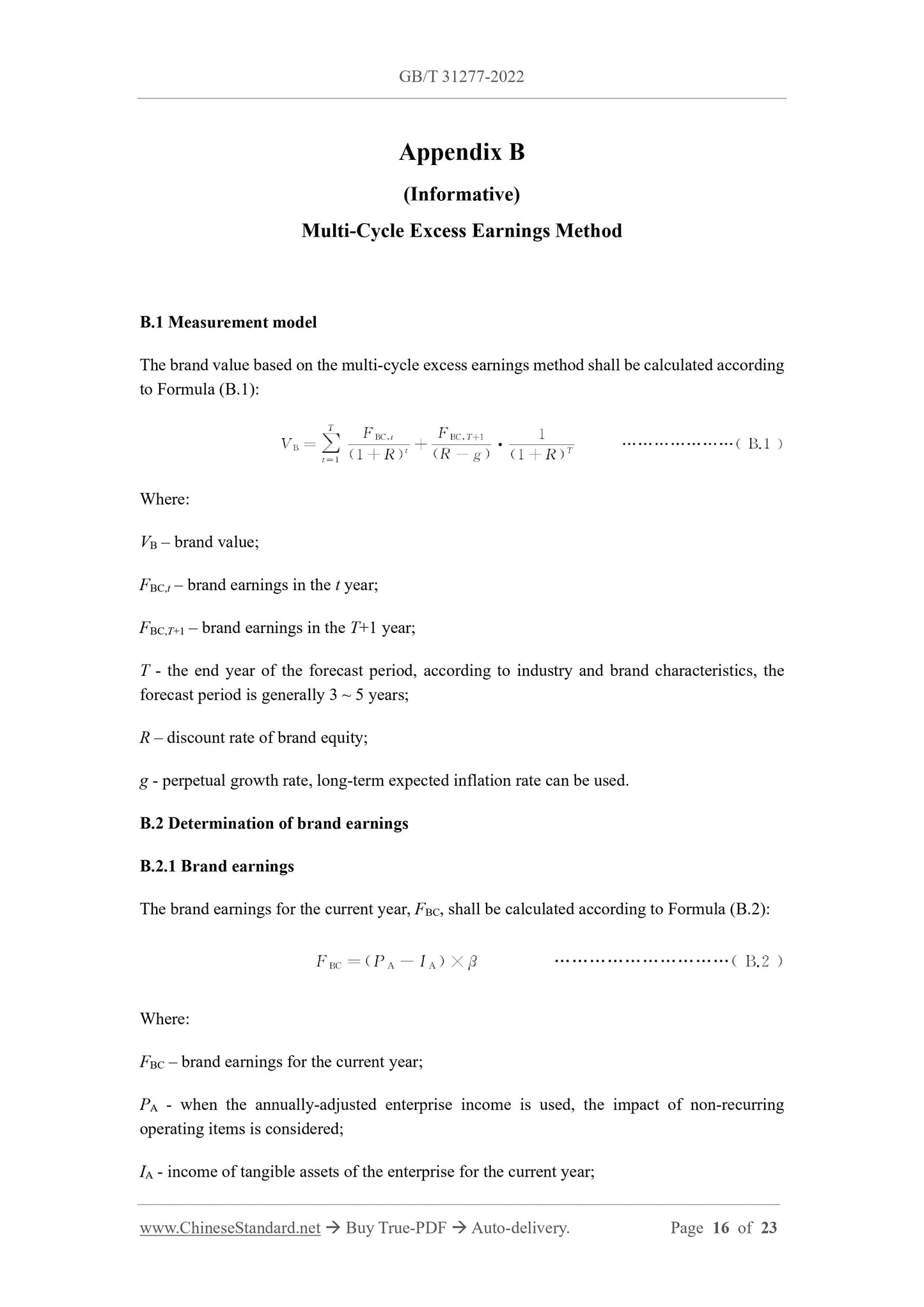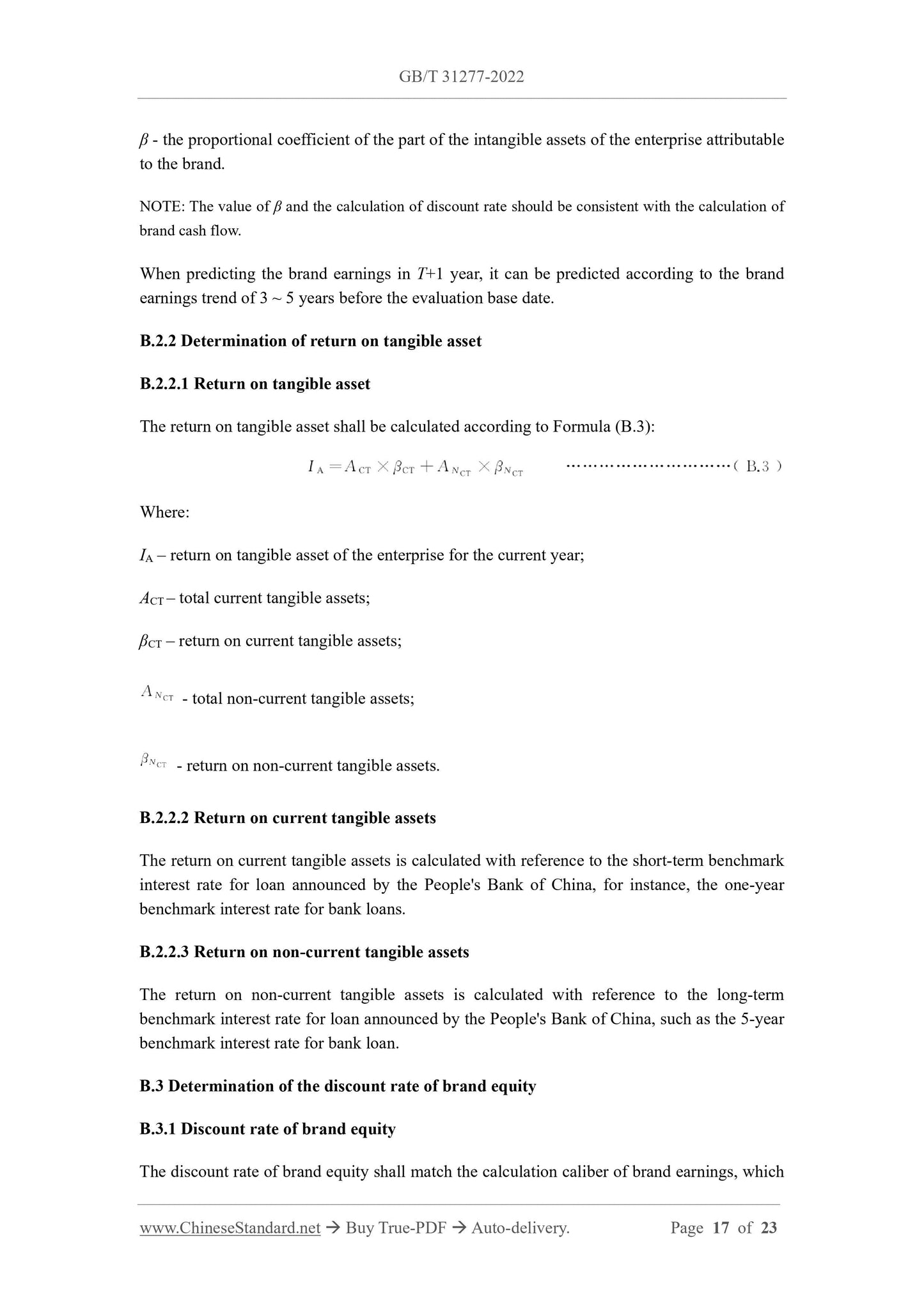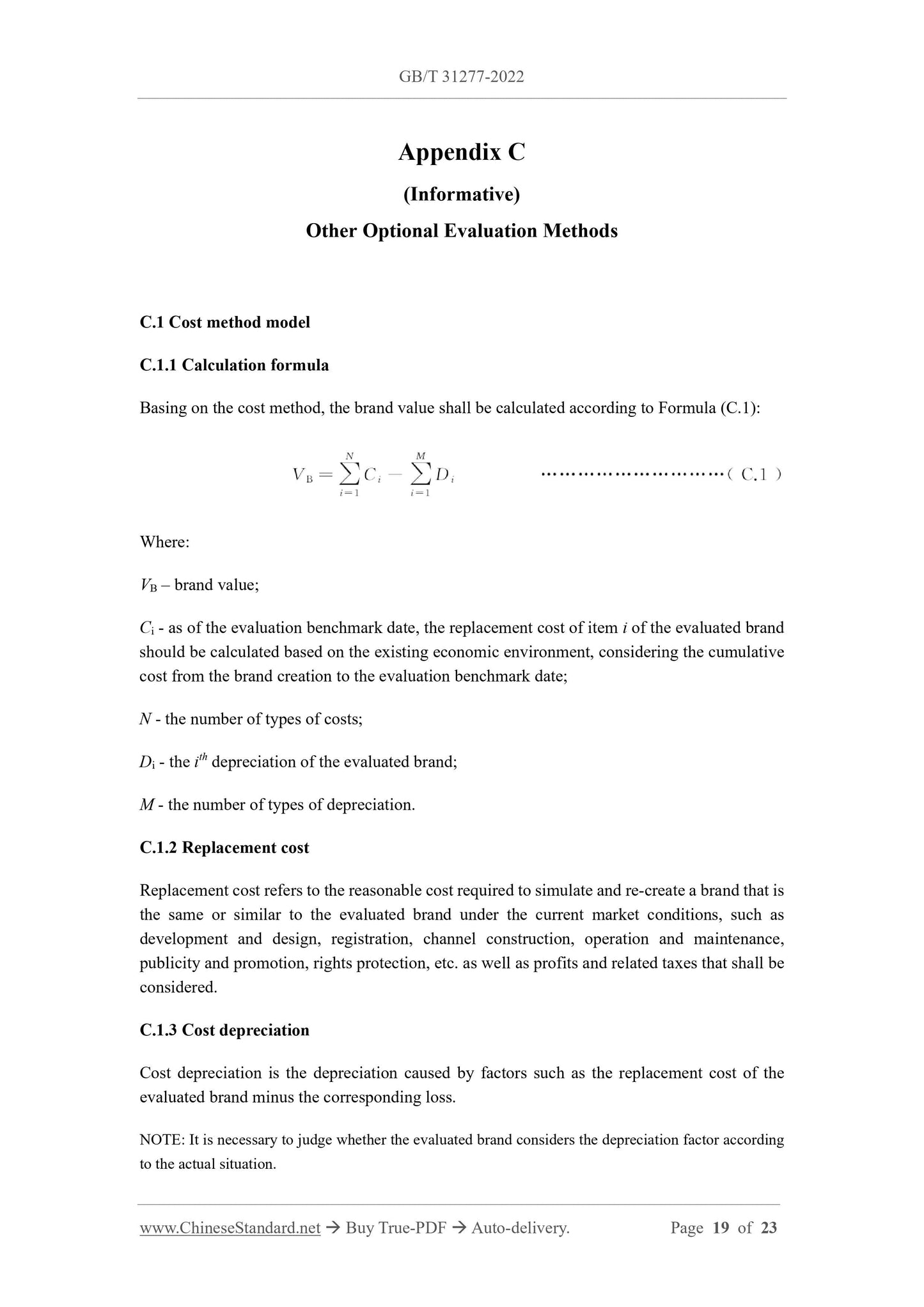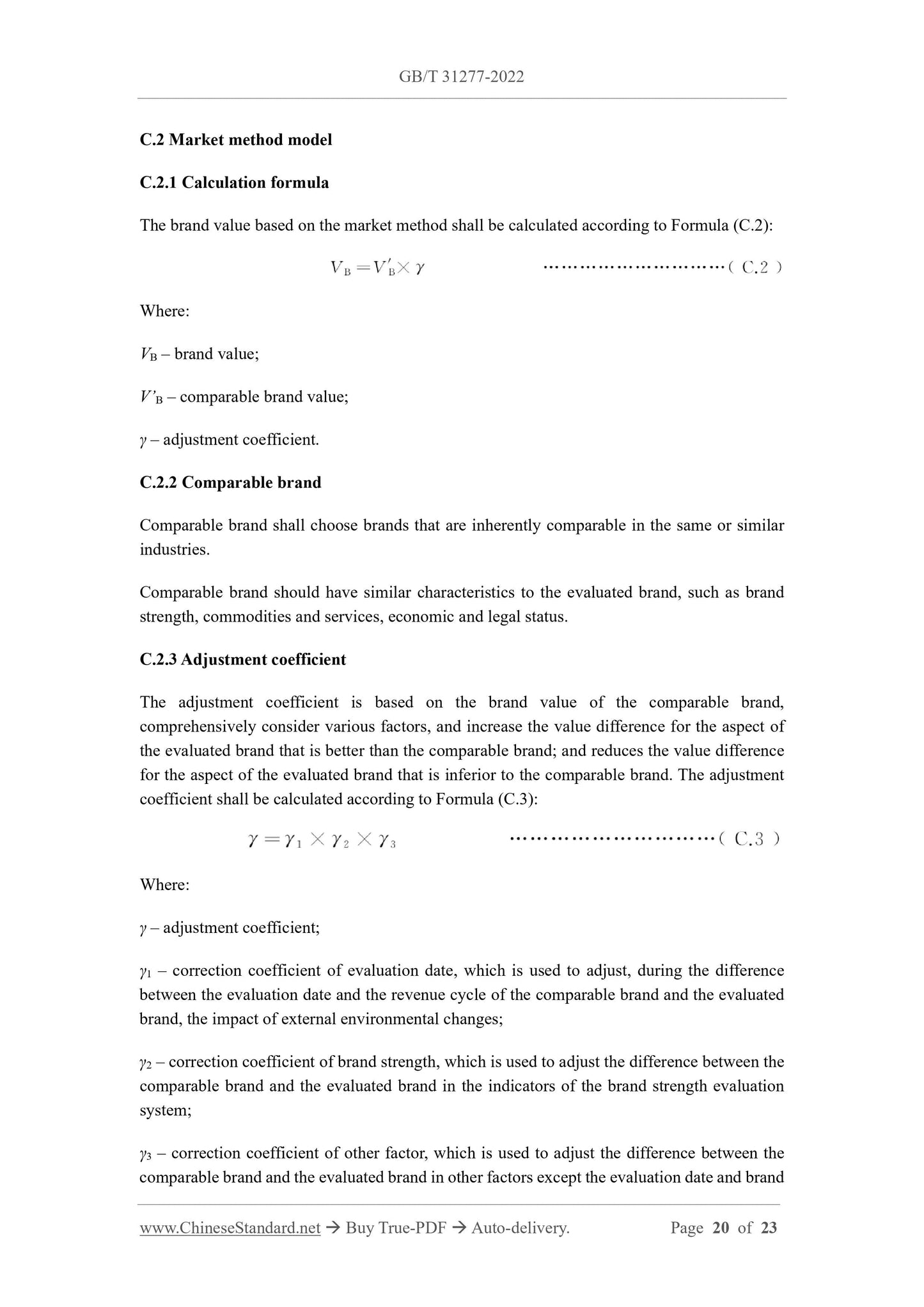1
/
of
11
www.ChineseStandard.us -- Field Test Asia Pte. Ltd.
GB/T 31277-2022 English PDF (GB/T31277-2022)
GB/T 31277-2022 English PDF (GB/T31277-2022)
Regular price
$290.00
Regular price
Sale price
$290.00
Unit price
/
per
Shipping calculated at checkout.
Couldn't load pickup availability
GB/T 31277-2022: Brand valuation - Retail industry
Delivery: 9 seconds. Download (& Email) true-PDF + Invoice.
Get Quotation: Click GB/T 31277-2022 (Self-service in 1-minute)
Historical versions (Master-website): GB/T 31277-2022
Preview True-PDF (Reload/Scroll-down if blank)
GB/T 31277-2022
NATIONAL STANDARD OF THE
PEOPLE’S REPUBLIC OF CHINA
ICS 03.140
CCS A 00
Replacing GB/T 31277-2014
Brand Valuation – Retail Industry
ISSUED ON: APRIL 15, 2022
IMPLEMENTED ON: NOVEMBER 01, 2022
Issued by: State Administration for Market Regulation;
Standardization Administration of the People’s Republic of China.
Table of Contents
Foreword ... 3
1 Scope ... 5
2 Normative References ... 5
3 Terms and Definitions ... 5
4 Brand Strength ... 5
5 Measurement Model of Brand Value ... 9
6 Evaluation Process of Brand Value ... 11
Appendix A (Informative) Evaluation Indicators and Instructions of Brand Strength 13
Appendix B (Informative) Multi-Cycle Excess Earnings Method ... 16
Appendix C (Informative) Other Optional Evaluation Methods ... 19
Bibliography ... 23
Brand Valuation – Retail Industry
1 Scope
This Document specifies the brand strength, measurement model, and evaluation process for
brand valuation in the retail industry.
This Document is suitable for brand valuation of retail enterprises, and can be used for self-
evaluation or third-party evaluation.
2 Normative References
The provisions in following documents become the essential provisions of this Document
through reference in this Document. For the dated documents, only the versions with the dates
indicated are applicable to this Document; for the undated documents, only the latest version
(including all the amendments) is applicable to this Document.
GB/T 18106 Classification of Retail Formats
GB/T 29185 Brand - Vocabulary
GB/T 29186 (all parts) Evaluation of Brand Value Elements
GB/T 29187 Brand Valuation - Requirements for Monetary Brand Valuation
GB/T 29188 Brand Valuation - Multi-Cycle Excess Earnings Method
3 Terms and Definitions
For the purposes of this Document, the terms and definitions given in GB/T 18106, GB/T 29185,
GB/T 29186 (all parts), GB/T 29187 and GB/T 29188 apply.
4 Brand Strength
4.1 General
The evaluation indicators of brand strength in retail industry include five Level-1 indicators:
tangible elements (K1), quality elements (K2), innovation elements (K3), service elements (K4)
and intangible elements (K5). For the evaluation content, evaluation elements and reference
scores of each Level-1 indicator, see Appendix A.
4.2 Tangible elements
4.2.1 Market performance
Evaluation indicators include but are not limited to:
---market share;
--- coverage.
4.2.2 Finance performance
Evaluation indicators include but are not limited to:
--- profitability;
--- debt paying ability;
--- operating ability;
--- development ability.
4.2.3 Related resources
Evaluation indicators include but are not limited to:
--- the investment of social and human resources;
--- the investment of environmental protection resources.
4.3 Quality elements
4.3.1 Quality management
Evaluation indicators include but are not limited to:
--- construction and operation of quality management system;
--- quality management performance;
--- supply chain management;
--- quality promise.
4.3.2 Commodity quality
4.5.3 Service outcome performance
Evaluation indicators include but are not limited to:
--- service satisfaction;
--- service improvement.
4.6 Intangible elements
4.6.1 Brand culture
Evaluation indicators include but are not limited to:
--- brand strategy;
--- fulfillment of social responsibilities.
4.6.2 Brand management
Evaluation indicators include but are not limited to:
--- management agency;
--- brand investment.
4.6.3 Brand influence
Evaluation indicators include but are not limited to:
--- brand influence;
--- brand honors;
--- brand loyalty;
--- brand history.
4.7 Calculation of brand strength
Brand strength K consists of fiveLevel-1 indicators, namely, tangible elements (K1), quality
elements (K2), innovation elements (K3), service elements (K4) and intangible elements (K5);
and the score is calculated according to Formula (1):
Where:
5.3 Other optional methods
5.3.1 Cost method
5.3.1.1 The cost method is an evaluation method to measure the brand value by deducting the
depreciation caused by various losses and other factors on the basis of the replacement cost of
building the brand. When the cost method is adopted, the evaluated brand shall meet but not
limited to the following conditions:
--- the evaluated brand can continue to be used, that is, it can bring expected benefits to its
owner;
--- have cost information on brand creation and maintenance;
--- be able to measure the depreciation that affects the brand value.
5.3.1.2 For the measurement model of the cost method, refer to the method in C.1 of Appendix
C.
5.3.2 Market method
5.3.2.1 The market method is to measure the value of the evaluated brand by comparing the
similarities and differences of the value of the evaluated brand and the comparable brand, and
adjusting the evaluation value of the comparable brand. When the market method is adopted,
the evaluated brand shall satisfy but not limited to the following conditions:
--- there is a comparable brand similar to the evaluated brand;
--- be able to collect and obtain market information, financial information and other relevant
materials of comparable brands;
--- comparable brands generally select multiple brands in the same industry for comparison,
and select the most reasonable and appropriate brand from them;
--- there is a fully developed and active public market.
NOTE: There are few relevant cases of brands being traded as separate assets. In addition, even if data
on comparable objects are known, the characteristics of the evaluated brands may be significantly
different from those of these few traded brands.
5.3.2.2 For the measurement model of the market method, refer to the method in C.2 of
Appendix C.
5.3.3 Incremental cash flow method
5.3.3.1 The incremental cash flow method identifies the cash flow generated when the company
uses the brand compared with when the brand is not used. When the incremental cash flow
method is adopted, the evaluated brand shall satisfy but not limited to the following conditions:
--- the cash flow that generates cost savings when the subject of evaluation is not using the
brand;
--- the cash flow that generates additional profit when the subject of evaluation is not using
the brand.
5.3.3.2 For the measurement model of the incremental cash flow method, refer to the method
in C.3 of Appendix C.
6 Evaluation Process of Brand Value
6.1 Identify the evaluation purpose
The evaluation purpose is determined based on factors such as the intended use of the
measurement, the user of the result, and the characteristics of the measured brand. Different
evaluation purposes shall affect the evaluation procedure, measurement accuracy and result
reporting form.
6.2 Clarify the factors that influence value
The brand value measured in this Document shall comprehensively consider factors such as
finance, quality, innovation, service, brand building, and market, especially the impact of non-
financial factors such as quality, innovation, service, and market on brand value.
6.3 Describe the measured brand
The brand under evaluation shall be identified, defined and described, including its product
range, value range, etc. before the measurement.
6.4 Determine model parameters
According to the relevant national policies and regulations and the current market economic
situation, determine the evaluation year and evaluation cycle, cash flow forecasting method,
industry average return on assets and other indicators and parameters required for model
measurement.
6.5 Collect measurement data
Following the principles of truthfulness, accuracy and objectivity, collect corporate financial
and other information as input values for corporate or third-party evaluations.
6.6 Execute the measurement process
The measurement process includes:
Appendix B
(Informative)
Multi-Cycle Excess Earnings Method
B.1 Measurement model
The brand value based on the multi-cycle excess earnings method shall be calculated according
to Formula (B.1):
Where:
VB – brand value;
FBC,t – brand earnings in the t year;
FBC,T+1 – brand earnings in the T+1 year;
T - the end year of the forecast period, according to industry and brand characteristics, the
forecast period is generally 3 ~ 5 years;
R – discount rate of brand equity;
g - perpetual growth rate, long-term expected inflation rate can be used.
B.2 Determination of brand earnings
B.2.1 Brand earnings
The brand earnings for the current year, FBC, shall be calculated according to Formula (B.2):
Where:
FBC – brand earnings for the current year;
PA - when the annually-adjusted enterprise income is used, the impact of non-recurring
operating items is considered;
IA - income of tangible assets of the enterprise for the current year;
β - the proportional coefficient of the part of the intangible assets of the enterprise attributable
to the brand.
NOTE: The value of β and the calculation of discount rate should be consistent with the calculation of
brand cash flow.
When predicting the brand earnings in T+1 year, it can be predicted according to the brand
earnings trend of 3 ~ 5 years before the evaluation base date.
B.2.2 Determination of return on tangible asset
B.2.2.1 Return on tangible asset
The return on tangible asset shall be calculated according to Formula (B.3):
Where:
IA – return on tangible asset of the enterprise for the current year;
ACT – total current tangible assets;
βCT – return on current tangible assets;
- total non-current tangible assets;
- return on non-current tangible assets.
B.2.2.2 Return on current tangible assets
The return on current tangible assets is calculated with reference to the short-term benchmark
interest rate for loan announced by the People's Bank of China, for instance, the one-year
benchmark interest rate for bank loans.
B.2.2.3 Return on non-current tangible assets
The return on non-current tangible assets is calculated with reference to the long-term
benchmark interest rate for loan announced by the People's Bank of China, such as the 5-year
benchmark interest rate for bank loan.
B.3 Determination of the discount rate of brand equity
B.3.1 Discount rate of brand equity
The discount rate of brand equity shall match the calculation caliber of brand earnings, which
Appendix C
(Informative)
Other Optional Evaluation Methods
C.1 Cost method model
C.1.1 Calculation formula
Basing on the cost method, the brand value shall be calculated according to Formula (C.1):
Where:
VB – brand value;
Ci - as of the evaluation benchmark date, the replacement cost of item i of the evaluated brand
should be calculated based on the existing economic environment, considering the cumulative
cost from the brand creation to the evaluation benchmark date;
N - the number of types of costs;
Di - the ith depreciation of the evaluated brand;
M - the number of types of depreciation.
C.1.2 Replacement cost
Replacement cost refers to the reasonable cost required to simulate and re-create a brand that is
the same or similar to the evaluated brand under the current market conditions, such as
development and design, registration, channel construction, operation and maintenance,
publicity and promotion, rights protection, etc. as well as profits and related taxes that shall be
considered.
C.1.3 Cost depreciation
Cost depreciation is the depreciation caused by factors such as the replacement cost of the
evaluated brand minus the corresponding loss.
NOTE: It is necessary to judge whether the evaluated brand considers the depreciation factor according
to the actual situation.
C.2 Market method model
C.2.1 Calculation formula
The brand value based on the market method shall be calculated according to Formula (C.2):
Where:
VB – brand value;
V’B – comparable brand value;
γ – adjustment coefficient.
C.2.2 Comparable brand
Comparable brand shall choose brands that are inherently comparable in the same or similar
industries.
Comparable brand should have similar characteristics to the evaluated brand, such as brand
strength, commodities and services, economic and legal status.
C.2.3 Adjustment coefficient
The adjustment coefficient is based on the brand value of the comparable brand,
comprehensively consider various factors, and increase the value difference for the aspect of
the evaluated brand that is better than the comparable brand; and reduces the value difference
for the aspect of the evaluated brand that is inferior to the comparable brand. The adjustment
coefficient shall be calculated according to Formula (C.3):
Where:
γ – adjustment coefficient;
γ1 – correction coefficient of evaluation date, which is used to adjust, during the difference
between the evaluation date and the revenue cycle of the comparable brand and the evaluated
brand, the impact of external environmental changes;
γ2 – correction coefficient of brand strength, which is used to adjust the difference between the
comparable brand and the evaluated brand in the indicators of the brand strength evaluation
system;
γ3 – correction coefficient of other factor, which is used to adjust the difference between the
comparable brand and the evaluated brand in other factors except the evaluation date and brand
GB/T 31277-2022
NATIONAL STANDARD OF THE
PEOPLE’S REPUBLIC OF CHINA
ICS 03.140
CCS A 00
Replacing GB/T 31277-2014
Brand Valuation – Retail Industry
ISSUED ON: APRIL 15, 2022
IMPLEMENTED ON: NOVEMBER 01, 2022
Issued by: State Administration for Market Regulation;
Standardization Administration of the People’s Republic of China.
Table of Contents
Foreword ... 3
1 Scope ... 5
2 Normative References ... 5
3 Terms and Definitions ... 5
4 Brand Strength ... 5
5 Measurement Model of Brand Value ... 9
6 Evaluation...
Delivery: 9 seconds. Download (& Email) true-PDF + Invoice.
Get Quotation: Click GB/T 31277-2022 (Self-service in 1-minute)
Historical versions (Master-website): GB/T 31277-2022
Preview True-PDF (Reload/Scroll-down if blank)
GB/T 31277-2022
NATIONAL STANDARD OF THE
PEOPLE’S REPUBLIC OF CHINA
ICS 03.140
CCS A 00
Replacing GB/T 31277-2014
Brand Valuation – Retail Industry
ISSUED ON: APRIL 15, 2022
IMPLEMENTED ON: NOVEMBER 01, 2022
Issued by: State Administration for Market Regulation;
Standardization Administration of the People’s Republic of China.
Table of Contents
Foreword ... 3
1 Scope ... 5
2 Normative References ... 5
3 Terms and Definitions ... 5
4 Brand Strength ... 5
5 Measurement Model of Brand Value ... 9
6 Evaluation Process of Brand Value ... 11
Appendix A (Informative) Evaluation Indicators and Instructions of Brand Strength 13
Appendix B (Informative) Multi-Cycle Excess Earnings Method ... 16
Appendix C (Informative) Other Optional Evaluation Methods ... 19
Bibliography ... 23
Brand Valuation – Retail Industry
1 Scope
This Document specifies the brand strength, measurement model, and evaluation process for
brand valuation in the retail industry.
This Document is suitable for brand valuation of retail enterprises, and can be used for self-
evaluation or third-party evaluation.
2 Normative References
The provisions in following documents become the essential provisions of this Document
through reference in this Document. For the dated documents, only the versions with the dates
indicated are applicable to this Document; for the undated documents, only the latest version
(including all the amendments) is applicable to this Document.
GB/T 18106 Classification of Retail Formats
GB/T 29185 Brand - Vocabulary
GB/T 29186 (all parts) Evaluation of Brand Value Elements
GB/T 29187 Brand Valuation - Requirements for Monetary Brand Valuation
GB/T 29188 Brand Valuation - Multi-Cycle Excess Earnings Method
3 Terms and Definitions
For the purposes of this Document, the terms and definitions given in GB/T 18106, GB/T 29185,
GB/T 29186 (all parts), GB/T 29187 and GB/T 29188 apply.
4 Brand Strength
4.1 General
The evaluation indicators of brand strength in retail industry include five Level-1 indicators:
tangible elements (K1), quality elements (K2), innovation elements (K3), service elements (K4)
and intangible elements (K5). For the evaluation content, evaluation elements and reference
scores of each Level-1 indicator, see Appendix A.
4.2 Tangible elements
4.2.1 Market performance
Evaluation indicators include but are not limited to:
---market share;
--- coverage.
4.2.2 Finance performance
Evaluation indicators include but are not limited to:
--- profitability;
--- debt paying ability;
--- operating ability;
--- development ability.
4.2.3 Related resources
Evaluation indicators include but are not limited to:
--- the investment of social and human resources;
--- the investment of environmental protection resources.
4.3 Quality elements
4.3.1 Quality management
Evaluation indicators include but are not limited to:
--- construction and operation of quality management system;
--- quality management performance;
--- supply chain management;
--- quality promise.
4.3.2 Commodity quality
4.5.3 Service outcome performance
Evaluation indicators include but are not limited to:
--- service satisfaction;
--- service improvement.
4.6 Intangible elements
4.6.1 Brand culture
Evaluation indicators include but are not limited to:
--- brand strategy;
--- fulfillment of social responsibilities.
4.6.2 Brand management
Evaluation indicators include but are not limited to:
--- management agency;
--- brand investment.
4.6.3 Brand influence
Evaluation indicators include but are not limited to:
--- brand influence;
--- brand honors;
--- brand loyalty;
--- brand history.
4.7 Calculation of brand strength
Brand strength K consists of fiveLevel-1 indicators, namely, tangible elements (K1), quality
elements (K2), innovation elements (K3), service elements (K4) and intangible elements (K5);
and the score is calculated according to Formula (1):
Where:
5.3 Other optional methods
5.3.1 Cost method
5.3.1.1 The cost method is an evaluation method to measure the brand value by deducting the
depreciation caused by various losses and other factors on the basis of the replacement cost of
building the brand. When the cost method is adopted, the evaluated brand shall meet but not
limited to the following conditions:
--- the evaluated brand can continue to be used, that is, it can bring expected benefits to its
owner;
--- have cost information on brand creation and maintenance;
--- be able to measure the depreciation that affects the brand value.
5.3.1.2 For the measurement model of the cost method, refer to the method in C.1 of Appendix
C.
5.3.2 Market method
5.3.2.1 The market method is to measure the value of the evaluated brand by comparing the
similarities and differences of the value of the evaluated brand and the comparable brand, and
adjusting the evaluation value of the comparable brand. When the market method is adopted,
the evaluated brand shall satisfy but not limited to the following conditions:
--- there is a comparable brand similar to the evaluated brand;
--- be able to collect and obtain market information, financial information and other relevant
materials of comparable brands;
--- comparable brands generally select multiple brands in the same industry for comparison,
and select the most reasonable and appropriate brand from them;
--- there is a fully developed and active public market.
NOTE: There are few relevant cases of brands being traded as separate assets. In addition, even if data
on comparable objects are known, the characteristics of the evaluated brands may be significantly
different from those of these few traded brands.
5.3.2.2 For the measurement model of the market method, refer to the method in C.2 of
Appendix C.
5.3.3 Incremental cash flow method
5.3.3.1 The incremental cash flow method identifies the cash flow generated when the company
uses the brand compared with when the brand is not used. When the incremental cash flow
method is adopted, the evaluated brand shall satisfy but not limited to the following conditions:
--- the cash flow that generates cost savings when the subject of evaluation is not using the
brand;
--- the cash flow that generates additional profit when the subject of evaluation is not using
the brand.
5.3.3.2 For the measurement model of the incremental cash flow method, refer to the method
in C.3 of Appendix C.
6 Evaluation Process of Brand Value
6.1 Identify the evaluation purpose
The evaluation purpose is determined based on factors such as the intended use of the
measurement, the user of the result, and the characteristics of the measured brand. Different
evaluation purposes shall affect the evaluation procedure, measurement accuracy and result
reporting form.
6.2 Clarify the factors that influence value
The brand value measured in this Document shall comprehensively consider factors such as
finance, quality, innovation, service, brand building, and market, especially the impact of non-
financial factors such as quality, innovation, service, and market on brand value.
6.3 Describe the measured brand
The brand under evaluation shall be identified, defined and described, including its product
range, value range, etc. before the measurement.
6.4 Determine model parameters
According to the relevant national policies and regulations and the current market economic
situation, determine the evaluation year and evaluation cycle, cash flow forecasting method,
industry average return on assets and other indicators and parameters required for model
measurement.
6.5 Collect measurement data
Following the principles of truthfulness, accuracy and objectivity, collect corporate financial
and other information as input values for corporate or third-party evaluations.
6.6 Execute the measurement process
The measurement process includes:
Appendix B
(Informative)
Multi-Cycle Excess Earnings Method
B.1 Measurement model
The brand value based on the multi-cycle excess earnings method shall be calculated according
to Formula (B.1):
Where:
VB – brand value;
FBC,t – brand earnings in the t year;
FBC,T+1 – brand earnings in the T+1 year;
T - the end year of the forecast period, according to industry and brand characteristics, the
forecast period is generally 3 ~ 5 years;
R – discount rate of brand equity;
g - perpetual growth rate, long-term expected inflation rate can be used.
B.2 Determination of brand earnings
B.2.1 Brand earnings
The brand earnings for the current year, FBC, shall be calculated according to Formula (B.2):
Where:
FBC – brand earnings for the current year;
PA - when the annually-adjusted enterprise income is used, the impact of non-recurring
operating items is considered;
IA - income of tangible assets of the enterprise for the current year;
β - the proportional coefficient of the part of the intangible assets of the enterprise attributable
to the brand.
NOTE: The value of β and the calculation of discount rate should be consistent with the calculation of
brand cash flow.
When predicting the brand earnings in T+1 year, it can be predicted according to the brand
earnings trend of 3 ~ 5 years before the evaluation base date.
B.2.2 Determination of return on tangible asset
B.2.2.1 Return on tangible asset
The return on tangible asset shall be calculated according to Formula (B.3):
Where:
IA – return on tangible asset of the enterprise for the current year;
ACT – total current tangible assets;
βCT – return on current tangible assets;
- total non-current tangible assets;
- return on non-current tangible assets.
B.2.2.2 Return on current tangible assets
The return on current tangible assets is calculated with reference to the short-term benchmark
interest rate for loan announced by the People's Bank of China, for instance, the one-year
benchmark interest rate for bank loans.
B.2.2.3 Return on non-current tangible assets
The return on non-current tangible assets is calculated with reference to the long-term
benchmark interest rate for loan announced by the People's Bank of China, such as the 5-year
benchmark interest rate for bank loan.
B.3 Determination of the discount rate of brand equity
B.3.1 Discount rate of brand equity
The discount rate of brand equity shall match the calculation caliber of brand earnings, which
Appendix C
(Informative)
Other Optional Evaluation Methods
C.1 Cost method model
C.1.1 Calculation formula
Basing on the cost method, the brand value shall be calculated according to Formula (C.1):
Where:
VB – brand value;
Ci - as of the evaluation benchmark date, the replacement cost of item i of the evaluated brand
should be calculated based on the existing economic environment, considering the cumulative
cost from the brand creation to the evaluation benchmark date;
N - the number of types of costs;
Di - the ith depreciation of the evaluated brand;
M - the number of types of depreciation.
C.1.2 Replacement cost
Replacement cost refers to the reasonable cost required to simulate and re-create a brand that is
the same or similar to the evaluated brand under the current market conditions, such as
development and design, registration, channel construction, operation and maintenance,
publicity and promotion, rights protection, etc. as well as profits and related taxes that shall be
considered.
C.1.3 Cost depreciation
Cost depreciation is the depreciation caused by factors such as the replacement cost of the
evaluated brand minus the corresponding loss.
NOTE: It is necessary to judge whether the evaluated brand considers the depreciation factor according
to the actual situation.
C.2 Market method model
C.2.1 Calculation formula
The brand value based on the market method shall be calculated according to Formula (C.2):
Where:
VB – brand value;
V’B – comparable brand value;
γ – adjustment coefficient.
C.2.2 Comparable brand
Comparable brand shall choose brands that are inherently comparable in the same or similar
industries.
Comparable brand should have similar characteristics to the evaluated brand, such as brand
strength, commodities and services, economic and legal status.
C.2.3 Adjustment coefficient
The adjustment coefficient is based on the brand value of the comparable brand,
comprehensively consider various factors, and increase the value difference for the aspect of
the evaluated brand that is better than the comparable brand; and reduces the value difference
for the aspect of the evaluated brand that is inferior to the comparable brand. The adjustment
coefficient shall be calculated according to Formula (C.3):
Where:
γ – adjustment coefficient;
γ1 – correction coefficient of evaluation date, which is used to adjust, during the difference
between the evaluation date and the revenue cycle of the comparable brand and the evaluated
brand, the impact of external environmental changes;
γ2 – correction coefficient of brand strength, which is used to adjust the difference between the
comparable brand and the evaluated brand in the indicators of the brand strength evaluation
system;
γ3 – correction coefficient of other factor, which is used to adjust the difference between the
comparable brand and the evaluated brand in other factors except the evaluation date and brand
GB/T 31277-2022
NATIONAL STANDARD OF THE
PEOPLE’S REPUBLIC OF CHINA
ICS 03.140
CCS A 00
Replacing GB/T 31277-2014
Brand Valuation – Retail Industry
ISSUED ON: APRIL 15, 2022
IMPLEMENTED ON: NOVEMBER 01, 2022
Issued by: State Administration for Market Regulation;
Standardization Administration of the People’s Republic of China.
Table of Contents
Foreword ... 3
1 Scope ... 5
2 Normative References ... 5
3 Terms and Definitions ... 5
4 Brand Strength ... 5
5 Measurement Model of Brand Value ... 9
6 Evaluation...
Share
